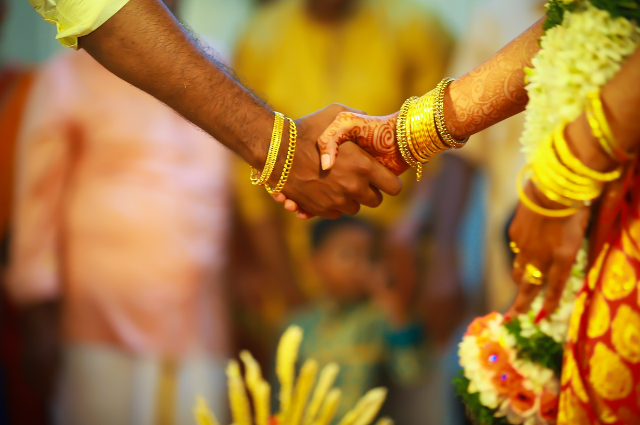
Image by ANOOP VS from Pixabay
Intercultural marriages have become increasingly common in our globalised world, bringing together individuals from diverse backgrounds, cultures, and traditions. However, when it comes to Intercultural unions, the practice of dowry can play a significant role, serving either as a bridge that fosters understanding or as a barrier that perpetuates cultural divides. In this article, we will explore the intricate dynamics of dowry in Intercultural Marriages, examining its impact, providing real-time examples, and proposing innovative perspectives.
THE BRIDGE THAT CONNECTS
- CULTURAL EXCHANGE AND CELEBRATION: In some intercultural marriages, dowry can serve as a bridge, facilitating cultural exchange and celebration. Instead of being seen as a transaction, dowry can be reframed as a symbolic gesture of embracing and appreciating the traditions and heritage of both families involved. For instance, a bride from India marrying into a Western family may present items of cultural significance from her homeland such as traditional clothing, artwork, or handicrafts, promoting cultural understanding and appreciation. A notable example is the intercultural marriage between Emma, a British woman, and Ravi, an Indian man. As part of their wedding, Emma's family collaborated with Ravi's family to create a dowry that encompassed elements from both cultures. Emma received a beautifully embroidered sari, intricately crafted Indian jewellery, and a collection of traditional Indian spices and cookbooks. These thoughtful gifts served as a symbolic representation of their commitment to honouring each other's cultures and building a bridge of understanding.
- STRENGTHENING FAMILY BONDS: Dowry can be an opportunity for families to come together, fostering stronger bonds between married individuals and their respective families. By exchanging gifts and engaging in discussions surrounding dowry, families can deepen their understanding of each other's values, customs, and aspirations. This process can build a foundation of trust, respect, and mutual support within intercultural marriage. Sarah, an American woman, and Raj, an Indian man decided to tie the knot recognizing the significance of dowry in Indian culture, Sarah's family took an unique approach. Instead of viewing dowry as a burden, they saw it as an opportunity to bridge the cultural gap between the two families. Sarah's family collaborated with Raj's family to curate a dowry that encompassed elements from both cultures. They included traditional Indian jewellery alongside Western artifacts that reflected Sarah's heritage. This thoughtful blend served as a symbolic representation of their commitment to a shared future and their respect for each other's backgrounds.
THE BARRIER THAT DIVIDES
- REINFORCING STEREOTYPES AND GENDER INEQUALITY: In some cases, dowry can reinforce stereotypes and perpetuate gender inequality within intercultural marriages. The expectation of dowry may place pressure on the bride and her family, treating her as an object of exchange rather than an equal partner in the marriage. Such practices can create power imbalances, hindering the establishment of truly egalitarian relationships. Amira, a Pakistani woman, and Michael, an American man, embarked on an intercultural marriage. However, cultural expectations regarding dowry posed significant barriers. Amira's family faced intense pressure to provide a substantial dowry, reinforcing the traditional gender role and expectations. This caused friction within the relationship as Amira felt devalued and her family struggled financially to meet the demands. Ultimately the dowry issues become a significant barrier to their intercultural union.
- FINANCIAL STRAIN AND CONFLICT: Dowry demand can lead to financial strain and conflict within intercultural marriages. If the requested dowry exceeds the means of the bride's family, it can lead to significant financial burdens and even debt. This financial pressure can strain relationships, create resentment, and hinder the formation of a harmonious union. Ahmed, an Iraqi man, and Maria, a Swedish woman, fell in love and decided to marry. However, cultural clashes arose when Ahmed's family insisted on a substantial dowry, following their traditional customs. Maria's family found themselves torn between honouring their daughter's happiness and the financial strain the dowry demands would impose. Despite their love for each other, the dowry dispute eventually caused irreparable damage to the relationship, leading to its dissolution. This example showcases how dowry expectations can act as formidable barriers, to understanding the potential for intercultural unity.
INNOVATION PERSPECTIVES AND SOLUTIONS
- EDUCATION AND AWARENESS: Promoting education and awareness about the negative consequences of dowry practices can help challenge the societal norms associated with dowry in Intercultural marriage. By fostering and encouraging open conversation, individuals and families can work together to eradicate harmful dowry expectations and promote a healthier intercultural union.
- LEGAL REFORMS: Government can play a crucial role in addressing dowry-related issues by implementing stricter legal measures and enforcement. Laws should aim to protect individuals from dowry demands, provide support systems for victims, and ensure penalties for those who engage in dowry-related offenses.
- REDEFINING DOWRY: An innovative approach would be to redefine the concept of dowry within intercultural marriage. Instead of focusing on material possession, dowry could be transformed into a symbolic exchange of values, aspirations, and shared commitments. This shift would emphasise the importance of emotional connections, mutual respect, and the celebration of a diverse cultural background.
- PRE- MARITAL COUNSELLING: Introducing pre-marital counseling programs that address intercultural dynamics and potential challenges can help couples navigate cultural differences and dowry-related expectations. These programs can provide a safe space for open discussions, promote mutual understanding and equip couples with effective communication and conflict-resolution skills.
CONCLUSION:
In conclusion, dowry can either act as a bridge or a barrier to intercultural marriages, depending on how it is approached and perceived. While it has the potential to foster cultural exchange and strengthen family bonds, it can also perpetuate gender inequality, reinforce stereotypes, and create financial strain. By reimagining dowry as a symbol of cultural appreciation promoting education, legal reforms, and innovative perspectives, we can strive to create an intercultural union that embraces diversity, equality, and mutual respect. It is through such efforts that dowry can truly become a bridge, connecting individuals across cultures and fostering harmonious intercultural marriage in our ever-evolving world.
